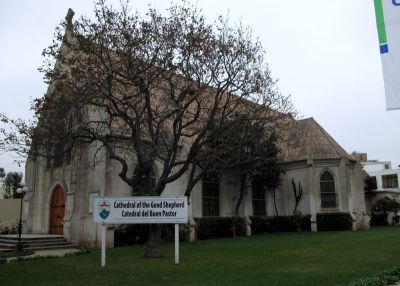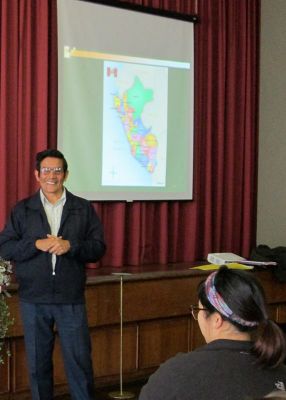One by One, Lecturers Shed Light on Peru
During the first six weeks of our SST semester in Peru, more than a dozen people provided presentations (often with PowerPoint slides), on subjects like the War of the Pacific, food and the Peruvian trademark, health care, the Catholic Church, the Shining Path, poetry and more.

Classes were held four days a week at la Catedral del Buen Pastor (the Cathedral of the Good Shepherd), an Anglican church in the Miraflores district of Lima. Mornings were usually reserved for lectures and workshops, with instruction in Spanish and sign language in the afternoon.
As in the past, one of our initial speakers was a pastor from Buen Pastor, the Rev. Jorge Zamudio (who also offered the benediction at the despedida, a farewell party for host families and other friends of Goshen College).

All told, students heard from 14 guest lecturers (workshop presenters will be noted in a separate post). Five of the speakers spoke on subjects related to the deaf community, often sharing personal stories of how they came to be deaf or to study sign language. Many speakers stayed to share lunch with us, which allowed for more time to talk with them informally.
Here is a sampling of our speakers (with pictures of a few more):
- Jerry Acosta, a former banker and now an Anglican pastor, told his painful personal story about surviving the violence and turmoil during the military’s war against Shining Path rebels in the 1980s and 1990s.
- Jimmy Arimborgo, an interpreter on Peruvian TV and a advocate for the deaf community, talked about his introduction to the world of signs.
- Father Eduardo Arens, Peru’s foremost theologian, who spoke about Jesus’ sense of humor and love for marginalized people. “Love and humor are often bound together,” Father Arens said.
- Dr. Townsend Cooper, a medical missionary with the Anglican Church, talked about his work in some of Lima’s poorest neighborhoods and about Peru’s health care system.
- Celia Luz Flores Flores, a poet and teacher, offered dramatic readings of her own poetry and invited students to join her in several expressive recitations in Spanish.
- Rafael León led us on a quick survey of key moments in 19th century Peruvian history, including independence from Spain.
- Andrés Paredes introduced students to the history of the War of the Pacific through a board game of his own making, in which students become strategists on behalf of the disputants: Bolivia, Chile and Peru.
- Hugo Ronald Peña, leader of a deaf association in Lima, described efforts to standardize the use of signing for deaf children and their families.
- Monica Piscoya, a deaf woman, and Moises, her hearing brother and a translator, shared their story, including an account of the death of their mother and how Monica subsequently served as a mother figure for Moises, who as a young child thought he was deaf.
- Jose Peralta, a sociology professor, talked about environmental justice issues involved in the globalization of food and agriculture, and the push by large international corporations for more genetically modified crops. Peru has imposed a 10-year ban on GMOs. He shared a compelling video on the Peru brand, filmed in Peru, Nebraska.
- James W. Plunkett, an American businessman, provided an overview of Peru’s economic and political history, lacing his presentation with irony and humor. He noted that a former president, Alberto Fujimori, is in prison for corruption, though he is also credited with defeating the Shining Path.
- Judit Santilllana, director of the sign language program at Unión Bíblica, a church organization with ministries around the country, noted the challenges a deaf child will face upon entering school.
- Nestor Vergara Soria, a psychologist for a government agency that assists vulnerable populations, challenged students to look at life from the perspective of young adults living in the poorest neighborhoods.
Photos and captions courtesy of Karen Stoltzfus


































